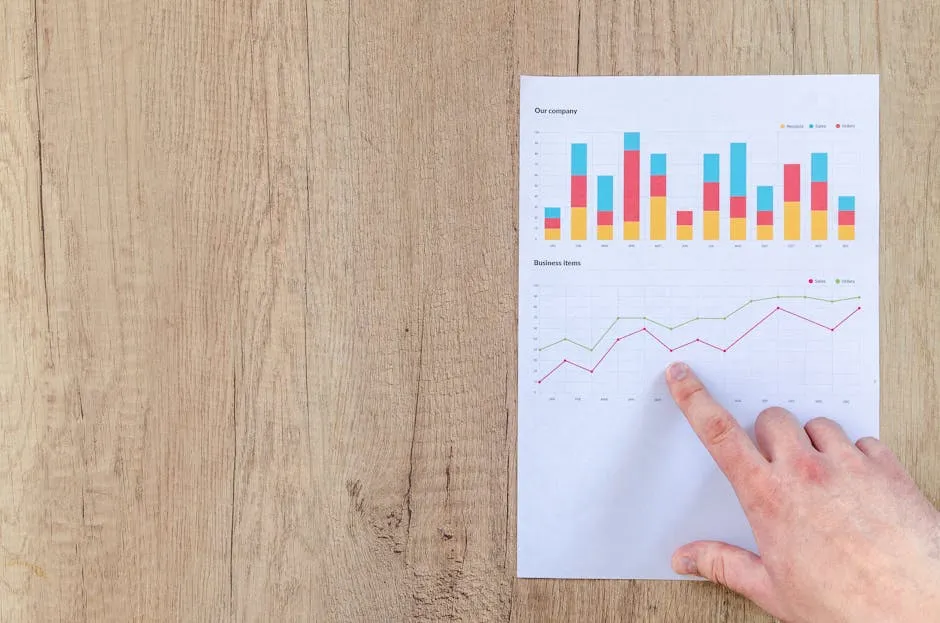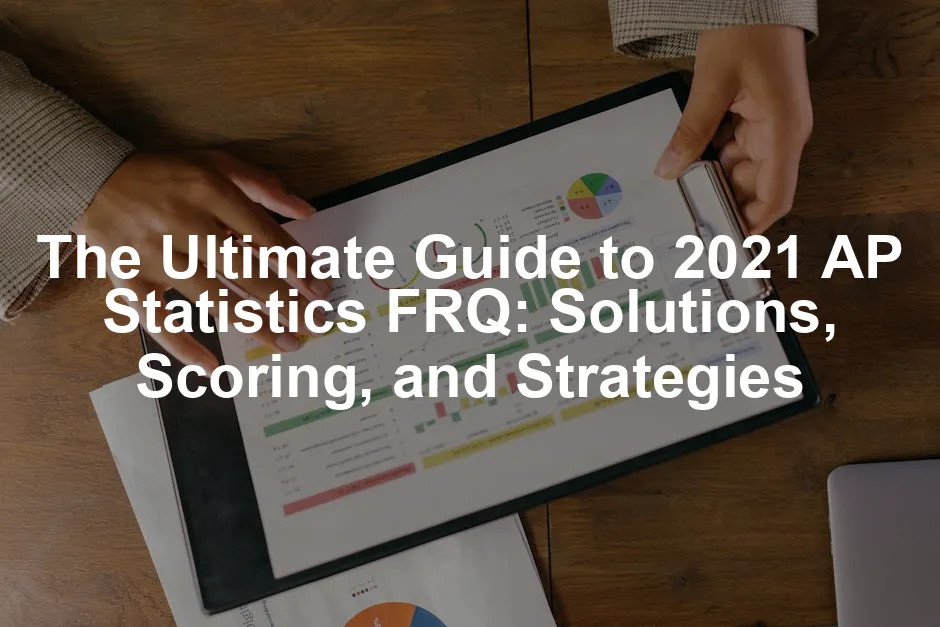Introduction
The 2021 AP Statistics Free Response Questions (FRQ) serve as a critical component of the exam. These questions allow students to demonstrate their understanding of statistical concepts and data analysis. A solid grasp of FRQs can significantly impact students’ overall scores, making them vital for exam success.
The AP Statistics exam consists of two sections: multiple-choice questions and free-response questions. Each section contributes equally to the final score, accounting for 50% each. The FRQs, in particular, require students to apply their knowledge in practical scenarios. They assess a range of skills, from data collection to hypothesis testing.
Mastering these questions is essential. Unlike multiple-choice questions, FRQs demand detailed reasoning and clear explanations. They are often more complex and require students to showcase their analytical abilities. By honing their skills in tackling FRQs, students can improve their chances of achieving high scores.

To gear up for the exam, consider picking up a great AP Statistics Prep Book. These books are designed to help you navigate through the complexities of the subject and boost your confidence before the big day.
This article aims to provide valuable insights into the 2021 AP Statistics FRQs. We will discuss detailed solutions, scoring guidelines, and effective strategies for approaching these challenging questions. Whether you’re a student gearing up for the exam or a teacher looking for resources, this guide is here to help you navigate the world of AP Statistics FRQs with confidence.
Understanding the AP Statistics Exam Format
Overview of the Exam Structure
The 2021 AP Statistics exam consists of two main sections: multiple-choice and free-response. The multiple-choice section includes 40 questions and accounts for 50% of the total score. Students have 1 hour and 30 minutes to complete this section. Meanwhile, the free-response section features six questions, also worth 50% of the score, with a time limit of 1 hour and 30 minutes.
The balance between these sections is crucial. Students must excel in both areas to maximize their scores. The free-response questions are particularly significant, as they provide an opportunity for students to showcase their problem-solving skills and understanding of statistical concepts in a more in-depth manner.

To tackle these questions effectively, having the right tools is key. A scientific calculator can make calculations a breeze, allowing you to focus on the concepts rather than getting bogged down in arithmetic. Plus, it’s a must-have for any statistics exam!
Breakdown of the Free Response Section
The free-response section is divided into two parts: Part A and Part B.
Part A consists of five multipart questions. These questions cover various topics, including data collection, exploration, probability, and inference. Students must demonstrate their understanding of these concepts by applying appropriate statistical methods and showing their work. Each question requires careful reading and analysis, as they often involve multiple components that build upon one another.
Part B features one investigative task. This task assesses students’ ability to integrate multiple statistical skills and content areas. It often involves real-world scenarios, requiring students to analyze data, draw conclusions, and justify their reasoning. This part is crucial, as it typically carries a higher point value than the individual questions in Part A, making it essential for scoring well on the exam. Completing this section effectively can significantly enhance a student’s overall performance.
Together, these components of the free-response section create a comprehensive assessment of students’ statistical knowledge and skills. Understanding the structure and expectations of the exam is the first step toward mastering the AP Statistics FRQs.
Analyzing the 2021 AP Statistics FRQ
Detailed Review of Each Question
Question 1: Investigating the Effect of a New Teaching Method
This question explores the impact of a novel teaching approach on students’ test scores. Students are required to analyze a dataset comparing scores from two different teaching methods.
To tackle this question, follow these steps:
- Identify the Variables: Clearly define the independent and dependent variables. Here, the teaching method is independent, while the test scores are dependent.
- Perform a Hypothesis Test: State your null and alternative hypotheses. For instance, \(H_0\): there is no difference in the means. \(H_a\): the new method yields higher scores.
- Calculate the Test Statistic: Use a t-test or z-test as appropriate. Ensure you calculate the mean and standard deviation for both groups.
- Determine the p-value: Use the test statistic to find the p-value from statistical tables or software.
- Draw a Conclusion: Compare the p-value to your significance level (commonly 0.05). If the p-value is less than 0.05, reject \(H_0\).
Common pitfalls include forgetting to define hypotheses clearly and miscalculating the test statistic. Ensure all calculations are double-checked, and always show your work for partial credit.

Question 2: Analyzing Survey Data
In this question, students analyze survey data regarding students’ study habits and their correlation with exam scores.
To break it down:
- Examine the Data: Begin by summarizing the data collected. What variables were measured?
- Correlation Analysis: Calculate the correlation coefficient to determine the relationship between study habits and exam performance.
- Interpret Results: Explain what the correlation coefficient indicates about the relationship. Remember, correlation does not imply causation.
- Graphical Representation: Create a scatterplot to visualize the relationship. Label axes and provide a title for clarity.
- Conclude: Draw conclusions based on your analysis. Discuss any implications or limitations of the data.
Avoiding common mistakes involves ensuring that proper statistical terminology is used. Mislabeling variables or misinterpreting correlation can lead to major errors.

Question 3: Confidence Intervals for Proportions
This question asks students to construct and interpret a confidence interval based on sample data.
Here’s how to approach it:
- Identify the Sample Data: Note the sample size and the proportion of successes in your data.
- Construct the Confidence Interval: Use the formula for the confidence interval for a proportion: \[ \text{CI} = \hat{p} \pm z \cdot \sqrt{\frac{\hat{p}(1 – \hat{p})}{n}} \] where \(\hat{p}\) is the sample proportion, \(z\) is the z-score for your confidence level, and \(n\) is the sample size.
- Interpret the Results: Explain what the confidence interval means in the context of the problem.
- Check Conditions: Ensure the sample size is large enough for the normal approximation to hold.
Common pitfalls include miscalculating the margin of error or misinterpreting the interval. Always verify your calculations and ensure your interpretation aligns with the statistical concepts.

Question 4: Comparing Two Population Means
Students are tasked with comparing the means of two different populations in this question.
Follow these steps for a solid response:
- State the Hypotheses: Formulate your null and alternative hypotheses. The null hypothesis might state that there is no difference between the two population means.
- Select the Appropriate Test: Depending on the data, this could be a t-test for independent samples or a paired t-test.
- Calculate the Test Statistic: Apply the correct formula for the test statistic based on your chosen test.
- Determine the p-value: Calculate the p-value corresponding to your test statistic.
- Draw Conclusions: Based on the p-value and your significance level, determine whether to reject or fail to reject the null hypothesis.
Students often overlook assumptions required for the tests, such as normality or equal variances. Always check these conditions before drawing conclusions.

Question 5: Investigating a New Drug’s Effectiveness
This question examines the effectiveness of a new drug aimed at reducing cholesterol levels. Students need to analyze data from a clinical trial to determine if the drug works better than a placebo.
To solve this, follow these steps:
- Define Variables: Identify independent (drug vs. placebo) and dependent (cholesterol levels) variables. Clarity here is crucial.
- State Hypotheses: Clearly lay out your null hypothesis (\(H_0\)): the drug has no effect. The alternative (\(H_a\)): the drug does improve cholesterol levels.
- Choose the Right Test: A two-sample t-test is appropriate for comparing the means of two groups.
- Calculate the Test Statistic: Use the formula for the t-test, which compares the means and standard deviations of both groups.
- Find the p-value: Use statistical software or tables to determine the p-value corresponding to your test statistic.
- Make Conclusions: If the p-value is less than your significance level (commonly 0.05), reject \(H_0\). Discuss what this means in context.
Common pitfalls include failing to state hypotheses clearly or miscalculating the test statistic. Always double-check your calculations, and remember to communicate your reasoning for full credit.

Question 6: Analyzing Customer Satisfaction Survey Results
In this question, students analyze data from a customer satisfaction survey aimed at improving a service. The goal is to assess whether a new service initiative led to higher satisfaction ratings.
To tackle this question effectively:
- Summarize the Data: Start by summarizing the survey results. What specific questions were asked? What metrics are we examining?
- Conduct a Hypothesis Test: Set up your null hypothesis (\(H_0\)): the new initiative has no effect on satisfaction. The alternative (\(H_a\)): it does increase satisfaction.
- Select the Right Test: Depending on data type, a chi-square test may be appropriate for categorical data.
- Calculate the Chi-Square Statistic: Use the observed and expected frequencies to calculate the chi-square statistic.
- Determine the p-value: Compare your chi-square statistic against critical values from the chi-square distribution table.
- Draw Conclusions: If the p-value is under 0.05, reject \(H_0\). Discuss what this means for the service initiative.
Common mistakes include overlooking the assumptions of the chi-square test. Ensure the data meets the required conditions, like having expected frequencies above five. This attention to detail can prevent costly misinterpretations.

Scoring Guidelines for 2021 AP Statistics FRQ
Overview of Scoring Criteria
Scoring responses to free-response questions (FRQs) on the AP Statistics exam involves a structured approach. Each response is evaluated based on its clarity, correctness, and the completeness of the work shown. The scoring rubric typically includes categories such as:
- Essentially Correct: The response meets all criteria with clear, accurate calculations and explanations.
- Partially Correct: Some elements are correct, but there are minor errors in calculations or reasoning.
- Incorrect: The response is either off-topic or lacks sufficient work to demonstrate understanding.
Examiners look for logical reasoning, proper statistical techniques, and clear communication. A well-structured response earns higher scores.

To ensure you’re hitting all the marks, consider using an AP Statistics Exam Study Guide. These guides break down the essential topics and offer strategic tips to enhance your preparation.
Common Scoring Mistakes
Students often make the same blunders that lead to point deductions. Here are frequent issues:
- Skipping Steps: Not showing all calculations can cost valuable points. Always demonstrate your work.
- Misinterpreting Results: Failing to correctly interpret statistical results can mislead conclusions. Take time to explain your findings.
- Ignoring Assumptions: Not checking the assumptions of tests can invalidate results. Always verify conditions before proceeding.
To maximize scoring potential, focus on clarity, thoroughness, and relevance. Review scoring guidelines after practice exams to understand where improvements are needed. Always practice writing clearly and succinctly. This habit pays off in both understanding and scoring.

Strategies for Tackling AP Statistics FRQs
Effective Study Techniques
Mastering the AP Statistics Free Response Questions (FRQs) requires a well-thought-out study plan. Here are some practical techniques to help you get started.
First, practice makes perfect! Regularly work on past FRQs. This exposure helps familiarize you with question formats. You’ll also get a feel for the types of statistical concepts that pop up frequently.
Next, review scoring guidelines. Understanding how your responses are graded can highlight what examiners seek. Pay attention to the language they use and the steps they expect in your answers.

Don’t forget to analyze sample solutions! They provide insight into successful strategies and common pitfalls. When reviewing, ask yourself: What did this response do well? Where could it improve? This reflection sharpens your analytical skills.
Lastly, study in groups. Explaining concepts to peers reinforces your understanding. Plus, you can tackle different questions together. This collaborative environment often sparks new ideas and insights.
Exam Day Strategies
When exam day arrives, keeping your cool is essential. Here are tips to manage your time effectively during the test.
Start by reading through all the questions. Get an overview of what’s on your plate. Identify which questions seem easier and tackle those first. This approach builds momentum and boosts your confidence.
Allocate your time wisely. For the six FRQs, aim to spend about 15 minutes on each. That leaves time to brainstorm, write, and review your answers. If a question stumps you, move on. You can always return later!

When approaching each question, underline keywords. This trick ensures you focus on what the question specifically asks for. Are you calculating a mean? Justifying a conclusion? Clarity is key!
Finally, don’t forget to review your work. If time permits, go back and check your answers. Look for calculation errors or missed parts of the question. This final touch can make a difference between a good score and a great score!
Utilizing Available Resources
In the digital age, resources are abundant. Here’s how to maximize your study materials.
Start with the College Board’s official site. They provide past exam questions and scoring guidelines. This treasure trove helps you understand what standard is expected.
Additionally, online platforms like Khan Academy and Fiveable offer free resources tailored for AP Statistics. These sites include video tutorials, practice problems, and interactive quizzes.
Consider practice exams too. They replicate the test experience and help solidify your knowledge. Make sure to time yourself to simulate the exam environment.
Lastly, don’t shy away from seeking help. Tutoring services can offer personalized guidance. Whether through in-person sessions or online platforms, a tutor can clarify complex topics and provide tailored strategies.
By combining these study techniques, exam day strategies, and available resources, you’ll be well-prepared to tackle the AP Statistics FRQs with confidence. Happy studying!

Conclusion
Understanding the 2021 AP Statistics Free Response Questions (FRQs) is crucial for students aiming for high scores. These questions challenge students to apply their statistical knowledge in real-world scenarios. They require a blend of critical thinking and precise communication. The strategies discussed throughout this guide are designed to help students navigate these challenges.
First, mastering the format of the exam is key. Knowing how the FRQs are structured empowers students to approach them with confidence. Each question has its unique demands, and understanding these can prevent unnecessary mistakes. Moreover, practicing with past FRQs provides invaluable experience. It allows students to familiarize themselves with the types of questions they might encounter.
Secondly, the scoring guidelines highlight the importance of clarity and thoroughness. Each response is evaluated based on correctness, clarity, and completeness. Students should always show their work, as this can earn partial credit even if the final answer is incorrect. By adhering to the rubric, students can maximize their scoring potential.
Lastly, let’s not forget the psychological aspect of exam preparation. Approaching the exam with a positive mindset can significantly affect performance. Students should remind themselves that preparation pays off. Each study session, no matter how small, brings them one step closer to their goals.
So, gather your study materials, review those past FRQs, and dive into practice. The 2021 AP Statistics exam may seem daunting, but with the right strategies and a sprinkle of confidence, you can conquer it. Remember, the goal is not just to pass but to excel. So go ahead, tackle those FRQs, and let your statistical skills shine!
FAQs
What are the key topics covered in the 2021 AP Statistics exam?
The 2021 AP Statistics exam covers a range of key topics. Major areas include data analysis, probability, and inference. Students are tested on concepts from different units such as exploring one-variable and two-variable data, collecting data, and making statistical inferences. Understanding these topics prepares students for both multiple-choice and free-response sections.
How can I access past AP Statistics FRQs?
Accessing past AP Statistics FRQs is simple. The College Board’s official site provides downloadable free-response questions along with scoring guidelines and sample responses. Visit [AP Central](https://apcentral.collegeboard.org/courses/ap-statistics/exam/past-exam-questions) to find a treasure trove of past exam questions. This resource is invaluable for practice and familiarization with the exam format.
What is the best way to study for the AP Statistics FRQ?
Effective study for the AP Statistics FRQs involves several strategies. Begin by reviewing past FRQs and their solutions. This practice helps identify common question types. Additionally, consider forming a study group. Discussing concepts with peers can deepen understanding. Utilizing online resources, such as video tutorials and quizzes, can also enhance learning. Don’t forget to allocate time for reviewing scoring guidelines to understand what examiners look for.
How are the FRQs scored?
The FRQs are scored based on a rubric that assesses clarity, correctness, and completeness. Each response is rated as either essentially correct, partially correct, or incorrect. Essential correctness means all parts are accurate and well-explained. Partially correct responses have some correct elements but contain minor errors. Incorrect responses lack sufficient work or deviate from the question’s intent. This clear scoring system highlights the importance of showing all calculations.
How can I improve my statistical writing for FRQs?
Improving statistical writing for FRQs involves clarity and precision. Begin by defining all variables clearly in your responses. Use appropriate statistical terminology and ensure your explanations are straightforward. Structure your answers logically, breaking them into clear steps. Finally, always show your work. This practice not only clarifies your reasoning but also helps earn partial credit if the final answer is incorrect.
Please let us know what you think about our content by leaving a comment down below!
Thank you for reading till here 🙂
For those looking for a comprehensive overview of the AP Statistics exam, including the essential ap statistics formula sheet, this guide is invaluable.
And don’t forget to keep your study area organized! A desk organizer can help you keep all your study materials in one place, reducing the distractions during your focused study sessions!
Lastly, don’t underestimate the power of a good snack during your study breaks! Grab some energy bars to keep your energy levels up while you tackle those tough statistics questions!
All images from Pexels




